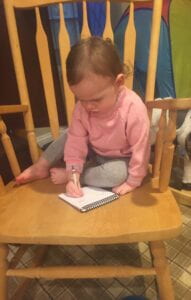
Having a blank slate can be simultaneously liberating and daunting. Endless possibilities are, by their nature, amorphous and elusive. In order for the potential to be realized, or the canvas to become something more than just blank, the artist must imagine a picture and find a starting point.
The picture I imagined at the onset of the doctoral program was a nebulous one, at best. To begin defining a picture, my first objective was to understand how children acquire handwriting proficiency and understand the roll of occupational therapy in this process. From this objective, my first two artifacts evolved.
___________________________________________________________________
Goal 1: Investigate, analyze, and summarize scientific evidence that examines handwriting acquisition for beginning writers with and without identified handwriting dysfunction. (AOTA 2021 Standards for Continuing Competence in Occupational Therapy: Knowledge, Professional Reasoning, Ethical Practice, Interpersonal Skills).
In setting my first goal, I generated both the demand and the opportunity to explore the vast clinical literature on handwriting pedagogy and the role of occupational therapy in handwriting acquisition. Developing this foundational understanding was a necessary first step for me in becoming well versed in a previously uncharted area. Equally important, was building this foundation on robust scientific research. Deeply embedded throughout every course I took at NYU, was the pragmatic proclamation that the confidence in occupational therapy interventions is irrefutably linked to evidence of efficacy. In particular, two courses guided my journey in reaching my first goal: Evidence Based Practice (taught be Grace Kim, PhD, OTR/L) and Successful Interventions in Schools and Early Intervention (taught by Winnie Dunn, PhD, OTR/L, FAOTA).
___________________________________________________________________________
I recall that the semester I was enrolled in the Evidence Based Practice course, I had a dining room table filled with research articles divided into stacks based on intervention type and large charts devoted to extracted data. Writing that preliminary systematic review and completing its final iteration felt like solving a riddle (or, in fact, a PICO question). With evidence neatly (mostly) organized on the table, I was able to establish the significant role that occupational therapy practitioners can play in handwriting acquisition for students, both with and without identified handwriting impairments.
_______________________________________________________________________________
The importance of evidence was highlighted with a different approach in Successful Interventions in School and Early Intervention. While completing an assignment for this course that investigates pseudoscience, I was awed by the quantity of products and services (found with a simple Google search) that are sold under the guise of “effective treatment.” For my second artifact, I wanted to explore common assumptions about handwriting. Here too, I found a striking dichotomy between the multitude of products that purportedly improve handwriting, and actual scientific evidence. The Write Way infographic was not meant to expose pseudoscience, but it is intended to profile current scientific evidence and provide practical recommendations.
____________________________________________________________________________